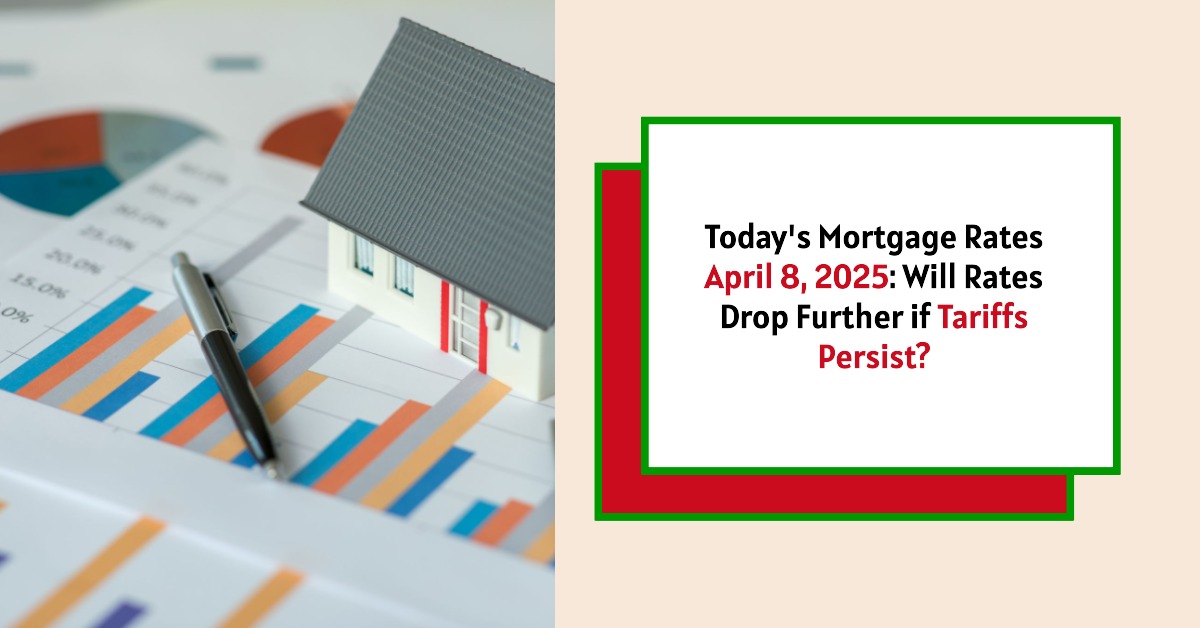Today's mortgage rates, as of April 8, 2025, show an average of approximately 6.50% for a 30-year fixed-rate mortgage. This figure reflects a slight decrease in rates following recent political news but remains susceptible to fluctuations due to inflationary pressures. Factors such as the recent announcement of new tariffs are causing market uncertainty that can impact both mortgage and refinance rates.
Today's Mortgage Rates April 8, 2025: Will Rates Drop Further if Tariffs Persist?
Key Takeaways:
- Current Average Mortgage Rate: Approximately 6.50% for 30-year fixed loans.
- Refinance Rates: Average 30-year refinance rates are about 6.49%, matching purchase rates.
- Tariff Impact: Recent tariffs could influence a rise in inflation, leading to potential higher rates upcoming.
- Different Loan Types: Rates vary significantly across mortgage types including FHA, VA, and ARMs.
Current Mortgage Rates (April 8, 2025)
| Mortgage Type | Average Rate |
|---|---|
| 30-Year Fixed | 6.50% |
| 15-Year Fixed | 5.80% |
| 7/1 ARM | 6.63% |
| 5/1 ARM | 6.50% |
| FHA Loans | 5.76% |
| VA Loans | 6.00% |
Source: Zillow
These rates come at a pivotal time as the housing market continues to navigate through economic challenges and changing financial landscapes. Understanding how these rates affect your home financing options is vital in making informed decisions.
Current Refinance Rates
| Refinance Type | Average Rate |
|---|---|
| 30-Year Refinance | 6.49% |
| 15-Year Refinance | 5.80% |
For homeowners considering refinancing, rates are closely aligned with purchase rates, offering some appealing options for those looking to lower their monthly payments or tap into home equity.
What Influences Mortgage Rates?
Mortgage rates are influenced by a variety of factors that extend beyond just economic indicators. Here are some of the critical areas to consider:
1. Economic Indicators
Economic data releases such as Gross Domestic Product (GDP) growth, unemployment rates, and inflation statistics play a significant role. When the economy is strong, employment is high, and consumer spending is robust, we may see upward pressure on interest rates. Conversely, weak economic data can lead to lower rates as the Federal Reserve may intervene to spur growth.
2. Federal Reserve Policies
The Federal Reserve's decisions regarding monetary policy heavily influence mortgage rates. When the Fed raises its federal funds rate, it makes borrowing more expensive, which typically translates to higher mortgage rates. Conversely, when the Fed cuts rates, it’s often because the economy needs a boost, leading to lower mortgage rates. Recent comments from Federal Reserve Chairman Jerome Powell suggest that the Fed is weighing potential inflation impacts due to tariffs as it navigates its monetary policy going forward.
3. Housing Market Dynamics
Supply and demand in the housing market can significantly influence rates. If home sales are robust and demand outstrips supply, home prices rise, which can push mortgage rates higher. In contrast, if there is a surplus of homes and fewer buyers, mortgage rates may drop as lenders compete for business.
4. Investor Behavior
Investor sentiment in the bond markets, specifically in mortgage-backed securities, directly impacts mortgage rates. If investors are optimistic about the economy and confident about the stock market, they might sell lower-yielding bonds, causing bond prices to drop and yields (which mortgage rates follow) to rise.
Impact of Recent Tariffs
Recently, President Trump announced significant new tariffs that have provoked various reactions across financial markets. While mortgage rates did see a brief drop initially due to market reshuffling, they have started to creep back up as traders digest the long-term impact of these tariffs. Tariffs can lead to an increase in production costs for companies, which can be passed on to consumers through increased prices.
Such inflationary pressures have far-reaching implications for mortgage rates in the future. Chairman Powell emphasized that increased tariffs could lead to higher inflation, further complicating the Federal Reserve's efforts to manage interest rates effectively. Market analysts are now speculating that any increase in inflation may prompt the Fed to raise rates sooner than expected.
Recommended Read:
Mortgage Rates Are Dropping Rapidly Day by Day Due to Tariffs
Mortgage Rates Trends as of April 7, 2025
Tariffs Push Mortgage Rates Down But Housing Costs Remain Record High
Mortgage Rates Likely to Go Down in the Short Term Due to Tariffs
Types of Mortgages Explained
Understanding the different types of mortgages available can help homebuyers select the right option for their unique financial situation:
- 30-Year Fixed-Rate Mortgages: These loans are the most common type for homebuyers. They offer a fixed interest rate for the entire duration of the loan, providing predictability in monthly payments. However, because of the long loan term, borrowers will generally pay more in interest over the life of the loan compared to shorter options.
- 15-Year Fixed-Rate Mortgages: Ideal for those who wish to repay their home more quickly, 15-year fixed-rate mortgages offer lower interest rates and allow homeowners to build equity faster. While the monthly payments are higher than those for a 30-year loan, homeowners pay significantly less in total interest.
- Adjustable-Rate Mortgages (ARMs): ARMs can come with lower introductory rates, which can be attractive to buyers. However, these loans come with the risk of increased payments after the initial fixed period. For example, a 7/1 ARM has a fixed rate for the first seven years, but after that, the rate adjusts annually based on market conditions.
- FHA Loans: Insured by the Federal Housing Administration, these loans are designed for lower-income and first-time buyers, requiring lower down payments and more lenient credit scores. A credit score of at least 580 is typical to qualify for a lower down payment of 3.5%, making this an appealing option for many hopeful homeowners.
- VA Loans: Offered to veterans and active military members, VA loans come with unique advantages including no required down payment and no need for private mortgage insurance (PMI). This can make them a compelling choice for eligible individuals looking to enter the housing market.
Overall Trends in Mortgage Rates
Over the past few months, there have been several fluctuations in mortgage rates due to a variety of factors including economic signals and global events. The average rate for a 30-year fixed mortgage today stands at 6.50%, slightly higher than previous monthly averages. This trend indicates a lingering uncertainty around the economic landscape, particularly in light of rising inflation concerns tied to tariffs and supply chain pressures.
- The previous month, rates were reported at 6.45%, marking an incremental increase that reflects the broader economic outlook. Experts project that any sustained increase in inflation could trigger a series of rate increases from the Fed, which would further complicate the homebuying environment.
- Historical trends show that mortgage rates have risen from their record lows during the pandemic. As of a few years ago, rates hovered around 3.00%, creating a stark contrast to today’s levels. This illustrates how quickly and dramatically shifts in economic policies and conditions can influence mortgage costs.
How to Analyze Refinancing Opportunities
Considering refinancing can be a strategic way to reduce monthly costs or tap into home equity. However, it's essential to perform thorough calculations to ensure it makes financial sense. The rule of thumb often suggests refinancing occurs if the new rate is at least 1% lower than the current one, but individual circumstances vary widely.
For example:
- If you currently have a 30-year mortgage at 6.50%, and you find a new rate at 5.50%, this offers potential savings. If your monthly payment can drop from $1,161 to $961, you could save $200 monthly. If your refinancing closing costs total $3,000, your break-even point would be in 15 months.
Additionally, it’s worthwhile to consider the potential tax implications of refinancing, and whether it will impact your future financial plans, including retirement savings, education funds, or other investments.
The Future of Mortgage Rates
Currently, mortgage rates seem poised for further changes depending on the evolution of the economy, particularly inflation trends, geographic housing demand, and ongoing Federal Reserve policies. While there is hope for a potential decrease in rates if inflation continues to stabilize, market analysts emphasize the complexity and unpredictability of these predictions.
The upcoming months will be crucial for homebuyers and those considering refinancing, as both economic indicators and market strategies will influence both the current environment and budget planning for the future.
Summary:
Backed by thorough and evolving analysis, today's mortgage rates reflect immense complexities in our economy. As we witness potential shifts in policy and economic behavior, staying informed about these mortgages becomes increasingly vital. This knowledge empowers borrowers to make educated financial decisions regarding home buying and refinancing in a currently unpredictable market.
Work With Norada, Your Trusted Source for
Real Estate Investment in the U.S.
Investing in turnkey real estate can help you secure consistent returns with fluctuating mortgage rates.
Expand your portfolio confidently, even in a shifting interest rate environment.
Speak with our expert investment counselors (No Obligation):
(800) 611-3060
Also Read:
- Will Mortgage Rates Go Down in 2025: Morgan Stanley's Forecast
- Expect High Mortgage Rates Until 2026: Fannie Mae's 2-Year Forecast
- Mortgage Rate Predictions 2025 from 4 Leading Housing Experts
- Mortgage Rates Forecast for the Next 3 Years: 2025 to 2027
- 30-Year Mortgage Rate Forecast for the Next 5 Years
- 15-Year Mortgage Rate Forecast for the Next 5 Years
- Why Are Mortgage Rates Going Up in 2025: Will Rates Drop?
- Why Are Mortgage Rates So High and Predictions for 2025
- Will Mortgage Rates Ever Be 3% Again in the Future?
- Mortgage Rates Predictions for Next 2 Years
- Mortgage Rate Predictions for Next 5 Years
- Mortgage Rate Predictions: Why 2% and 3% Rates are Out of Reach
- How Lower Mortgage Rates Can Save You Thousands?
- How to Get a Low Mortgage Interest Rate?
- Will Mortgage Rates Ever Be 4% Again?


